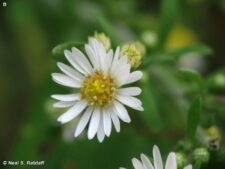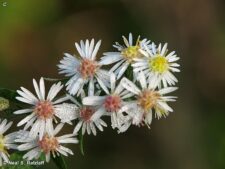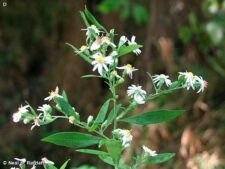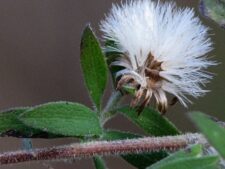
PANICLED ASTER
Symphyotrichum lanceolatum
SUNFLOWER FAMILY (Asteraceae)
 Identification
Identification
- Flowering time - August, September, October
- Common on floodplain at FF and NW
- Tall plant with many daisy-like flowers
- Lance-shaped leaves
- Difficult to separate from some other aster species - see comments
This native perennial grows from an underground stem (rhizome). One or more stout stems, some up to 7 feet tall, hold lance-shaped leaves (D). These are variable in size and shape, but smaller near the top. The flower heads up to 3/4 inch across occur in clusters (panicles). Individual flowers have numerous white ray florets surrounding the yellow disk florets which turn lavender as the flower matures (A,B,C). The seeds with their attached fluffy white hairs are dispersed by the wind (E).
This aster is found in wet areas near water, flowering from August through October. It is common in moist areas on the floodplain at both Fontenelle Forest and Neale Woods.
There are at least two other very similar Aster (now Symphyotrichum) species occurring in the same floodplain habitat which have been documented at Fontenelle Forest and Neale Woods. They are not included in this guide because their subtle differences are not easily identifiable in the field, sometimes requiring study under a microscope. Other species which are easier to identify are included elsewhere in this guide. See Heath Aster (Symphyotrichum ericoides) and Arrow-leaved Aster (S. sagittifolium).
Classification of this complex group continues to change. Recently many of the plants we commonly refer to as asters have been changed from the Aster genus to the genus Symphyotrichum including Panicled Aster, previously Aster simplex and now Symphyotrichum lanceolatum.
The content of NatureSearch is provided by dedicated volunteer Naturalists of Fontenelle Forest who strive to provide the most accurate information available. Contributors of the images retain their copyrights. The point of contact for this page is: Roland Barth.




